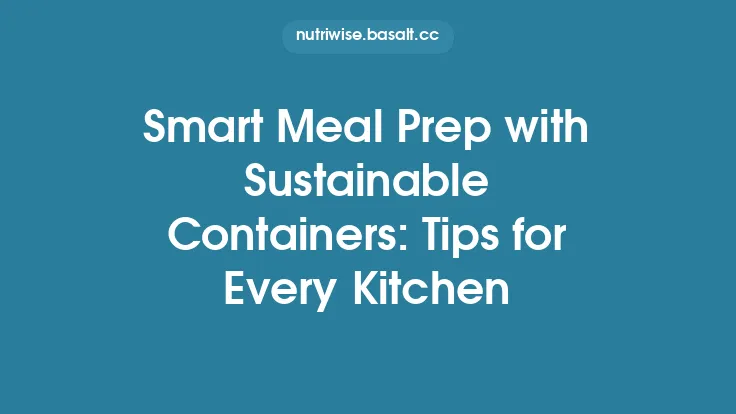When it comes to meal‑prep success, the refrigerator is the unsung hero that can either streamline your weekly cooking routine or turn it into a chaotic scramble. A well‑organized fridge not only saves precious time when you’re pulling together ingredients, it also helps you keep food safe, reduces waste, and makes it easier to see exactly what you have on hand. Below is a comprehensive, evergreen guide that walks you through every aspect of refrigerator organization—from understanding temperature zones to establishing a maintenance routine—so you can build a system that supports consistent, stress‑free meal planning.
Understanding Your Refrigerator’s Layout and Temperature Zones
Most modern refrigerators are designed with distinct temperature zones that serve different purposes:
| Zone | Typical Temperature | Ideal Use |
|---|---|---|
| Upper Shelves | 35‑38 °F (1.7‑3.3 °C) | Ready‑to‑eat foods (dairy, leftovers, pre‑portioned meals) |
| Middle Shelves | 35‑38 °F (1.7‑3.3 °C) | Packaged items (yogurt, cheese, deli meats) |
| Lower Shelves | 33‑36 °F (0.5‑2.2 °C) | Raw proteins (meat, poultry, fish) – colder area slows bacterial growth |
| Crisper Drawers | 32‑35 °F (0‑1.7 °C) with humidity control | Produce – high humidity for leafy greens, low humidity for fruits |
| Door Shelves | 40‑45 °F (4.4‑7.2 °C) | Condiments, drinks, and items that tolerate temperature fluctuations |
Understanding these zones lets you place foods where they stay freshest longest, and it prevents cross‑contamination (e.g., raw meat on the lower shelf away from ready‑to‑eat items).
Creating Functional Zones for Meal‑Prep Ingredients
Once you know the temperature map, carve out “functional zones” that align with your typical meal‑prep workflow:
- Protein Hub – Reserve the bottom shelf for all raw proteins, grouped by type (e.g., chicken, beef, fish). Use a dedicated tray or shallow pan to catch any drips and keep the shelf clean.
- Grab‑and‑Go Snacks – Allocate a section of the middle shelf for pre‑portioned snack packs (cut veggies, hummus, cheese sticks). Store them in clear containers so you can see inventory at a glance.
- Ready‑to‑Cook Ingredients – Use the upper shelf for pre‑marinated proteins, pre‑cooked grains, and sauces that will go straight into a pan or pot.
- Produce Drawer System – Split the crisper drawer into two compartments: high humidity for leafy greens and herbs, low humidity for berries, apples, and other fruits that release ethylene.
- Condiment Corner – Keep the door shelves organized by frequency of use: everyday staples (mustard, ketchup) at eye level, occasional items (sauces, specialty dressings) on the lower door.
By assigning each zone a clear purpose, you eliminate the “where did I put that?” moment and speed up the transition from fridge to cutting board.
Choosing the Right Containers and Materials
The containers you use can make or break your organization system. Here are the most fridge‑friendly options:
| Material | Pros | Cons |
|---|---|---|
| Clear BPA‑free plastic | Visibility, stackable, lightweight | Can retain odors if not sealed well |
| Glass with airtight lids | No odor transfer, microwave‑safe, durable | Heavier, can break |
| Stainless‑steel | No staining, sleek, durable | Opaque—harder to see contents |
| Silicone bags | Flexible, reusable, sealable | Not as rigid for stacking |
Key container features to prioritize:
- Uniform shape and size – Stackability is maximized when containers are the same dimensions.
- Airtight sealing – Prevents moisture loss and cross‑odor contamination.
- Label‑ready surface – Even if you avoid a full labeling system, a smooth area makes it easy to write quick notes with a dry‑erase marker.
Invest in a set of stackable containers that fit your fridge’s dimensions. Measure the interior width, height, and depth of each shelf before purchasing to avoid the dreaded “doesn’t fit” scenario.
Implementing a First‑In‑First‑Out (FIFO) System
Food waste is a silent enemy of meal‑prep efficiency. The FIFO method ensures you consume older items before newer ones:
- Date every perishable – Write the purchase or “use‑by” date on the container lid or a small sticky note.
- Place new items behind older ones – When you add fresh produce or proteins, slide them to the back of the drawer or shelf, pushing older items forward.
- Weekly inventory check – Spend five minutes each Sunday scanning the fridge, moving items that are nearing their date to the front of the zone.
A simple visual cue—such as a colored dot for items that need to be used within three days—helps you stay on top of the rotation without a complex tracking system.
Maintaining Food Safety and Freshness
Even the most organized fridge can’t compensate for unsafe storage practices. Follow these evergreen safety guidelines:
- Keep raw meat on the bottom shelf to prevent drips onto other foods.
- Store eggs in their original carton on a middle shelf, not the door, where temperature fluctuates.
- Avoid over‑packing – Air circulation is essential for consistent cooling. Leave a small gap between containers.
- Monitor fridge temperature – Use a fridge thermometer; the ideal range is 35‑38 °F (1.7‑3.3 °C). Adjust the thermostat if you notice frequent temperature spikes.
- Separate ethylene‑producing fruits (bananas, apples) from ethylene‑sensitive vegetables (broccoli, lettuce) to extend shelf life.
Integrating Your Refrigerator Organization with Weekly Meal Planning
Your fridge should be a visual extension of your meal plan. Here’s how to sync the two:
- Plan meals around existing inventory – Before you shop, review the contents of each zone and identify what you already have.
- Pre‑portion ingredients – For each planned recipe, create a dedicated container labeled with the meal name (e.g., “Taco Night – 2 lb ground turkey”). Store it in the “Ready‑to‑Cook” zone.
- Create a “Meal‑Prep Tray” – A shallow, compartmentalized tray on the upper shelf can hold all components for a single day’s meals, making it easy to grab and go.
- Reserve a “Leftover Slot” – Designate a specific container for leftovers each night. This encourages you to store them promptly, preserving quality and reducing waste.
When the fridge mirrors your weekly menu, you’ll spend less time rummaging and more time cooking.
Seasonal Adjustments and Special Considerations
Your refrigerator organization isn’t static; it should adapt to seasonal produce and lifestyle changes:
- Summer – Increase the low‑humidity compartment for berries and stone fruits, which spoil faster in warm weather.
- Winter – Expand the high‑humidity drawer for root vegetables and leafy greens that thrive in cooler, moist environments.
- Entertaining – Add a “Party Prep” zone on the door shelves for platters, dips, and pre‑made desserts that need quick access.
- Dietary shifts – If you transition to a plant‑based diet, allocate more space in the crisper for legumes, tofu, and plant‑based milks.
Regularly reassess your zones every few months to ensure they still align with your eating habits.
Cleaning and Maintenance Routine
A clean fridge is the foundation of any organization system. Adopt a simple, repeatable cleaning schedule:
| Frequency | Task |
|---|---|
| Daily | Wipe any spills immediately with a damp cloth. |
| Weekly | Remove all items, discard expired foods, and wipe shelves with a solution of warm water and mild dish soap. |
| Monthly | Deep clean drawers and door gaskets; run a baking‑soda solution (1 Tbsp per quart of water) to neutralize odors. |
| Quarterly | Defrost (if applicable) and vacuum the condenser coils behind the fridge to maintain efficient cooling. |
Incorporate the cleaning routine into your weekly meal‑prep ritual—e.g., clean the fridge while the oven preheats for Sunday’s batch cooking.
Troubleshooting Common Refrigerator Organization Challenges
| Problem | Likely Cause | Quick Fix |
|---|---|---|
| Items sliding off shelves | Shelves are too smooth or overloaded. | Add non‑slip shelf liners or use shallow containers with rubberized bases. |
| Condensation pooling in drawers | High humidity settings for the wrong produce. | Adjust the humidity dial: high for leafy greens, low for fruits. |
| Frequent temperature fluctuations | Door left open too long or over‑packed fridge. | Keep the door closed, reorganize to improve airflow, and check the door seal for gaps. |
| Odor transfer between foods | Inadequate sealing of containers. | Switch to airtight containers or double‑wrap strong‑smelling items (e.g., fish) in foil before placing them in a container. |
| Running out of space for meal‑prep containers | Containers too large or inefficient stacking. | Downsize to portion‑appropriate containers, or use stackable nesting bowls that collapse when not in use. |
Addressing these issues promptly prevents small annoyances from becoming major setbacks in your meal‑prep workflow.
Putting It All Together: A Sample Weekly Setup
Below is a concrete example of how the principles above can be applied to a typical Monday‑Sunday meal‑prep schedule:
| Day | Refrigerator Zone | Contents | Purpose |
|---|---|---|---|
| Monday | Bottom shelf (Protein Hub) | 2 lb chicken breasts (marinated) | Ready for grilling Tuesday dinner |
| Upper shelf (Ready‑to‑Cook) | 1 qt cooked quinoa (portion‑sized) | Quick side for multiple meals | |
| Crisper drawer (High humidity) | Bag of spinach, kale | Salads and stir‑fry greens | |
| Tuesday | Upper shelf | Pre‑portioned taco filling (ground turkey) | Taco night |
| Door shelf | Salsa, guacamole, lime wedges | Condiments for tacos | |
| Wednesday | Middle shelf | Greek yogurt (individual cups) | Breakfast/snack |
| Crisper drawer (Low humidity) | Berries (strawberries, blueberries) | Snack and smoothie base | |
| Thursday | Bottom shelf | Salmon fillets (wrapped) | Baked salmon dinner |
| Upper shelf | Pre‑made pesto sauce | Pasta night | |
| Friday | Door shelf | Bottled water, sparkling water | Hydration |
| Upper shelf | Leftover quinoa (to be used in Friday’s bowl) | Reduce waste | |
| Saturday | Crisper drawer | Mixed vegetables (carrots, bell peppers) | Stir‑fry for weekend dinner |
| Bottom shelf | Ground beef (for burgers) | Weekend grill | |
| Sunday | Upper shelf | Meal‑prep tray (breakfast bowls) | Easy grab‑and‑go for the week |
By the end of the week, the fridge returns to a near‑empty state, ready for the next cycle of shopping and planning. The visual layout makes it obvious what’s coming up, what needs to be used first, and where new items belong.
Final Thought
A refrigerator that works for you is more than a cold storage box; it’s a dynamic hub that supports your entire meal‑prep ecosystem. By mastering temperature zones, establishing purposeful zones, selecting the right containers, and committing to a simple FIFO and cleaning routine, you create an evergreen system that adapts to any season, diet, or schedule. Implement these strategies, and you’ll find that the time you once spent hunting for ingredients is now reclaimed for cooking, enjoying meals, and, ultimately, living healthier with less stress.





